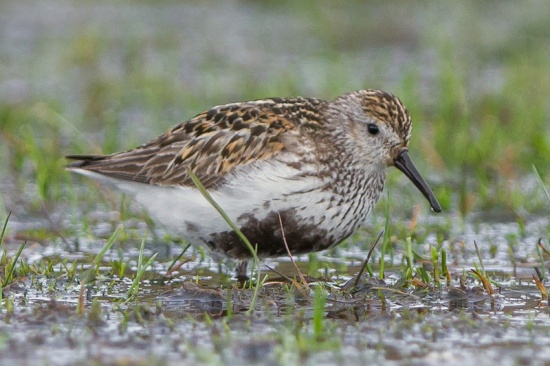
Photo © by Stein Nilsen
Svalbard, Norway, 3 August 2012
- Calidris alpina
Identification
Length 17–21 cm (6¾-8¼ in), wingspan 32–36 cm, weight 33–85 g
Black bill, with de-curved tip; black legs.
Breeding
- Crown and upperparts rufous, streaked darker
- Wings: greyish brown, with pale bar and dark tips
- White sides to rump and tail
- White breast with darker streaks
- Black belly
- White undertail coverts
Non-breeding
- Rufous areas become grey and belly all white
Juvenile
- Similar to summer adult above but fringes less rufous; underparts pale buff breast grading to white belly with blackish streaks on breast and flanks
Distribution
Breeding birds from northern Europe and Asia winter in western and southern Europe, Africa, and southern Asia. Those that breed in Alaska and the Canadian Arctic move down to the Pacific and Atlantic coasts of North America.
Taxonomy
Most closely related to the Purple Sandpiper — Rock Sandpiper species pair, and after them, to Sanderling[1].
Subspecies
Depending on authority, nine[2] or ten[3] subspecies are accepted:
- C. a. arctica:
- C. a. schinzii:
- Southeastern Greenland and Iceland to Britain and southern Scandinavia; winters from Britain to northwestern Africa
- C. a. alpina:
- Scandinavia to northwestern Russia; winters from Britain to Mediterranean
- C. a. centralis:
- C. a. sakhalina:
- C. a. kistchinskii:
- Sea of Okhotsk to Kuril Islands; wintering grounds unknown
- C. a. actites:
- Northern Sakhalin; wintering grounds unknown
- C. a. arcticola:
- C. a. pacifica:
- C. a. hudsonia:
The subspecies are distinguishable by bill length, and intensity of colour of the summer plumage. Winter and juvenile plumage birds are often not reliably distinguishable to subspecies, with only bill length differing.
Habitat
Breeds on low or high ground, in wet short-grass or tundra habitats; on migration (in autumn, adults in late July-August, juveniles in late August-October), found in a variety of marshy or coastal habitats, but most numerous on tidal flats or on banks of seaweed on shallow shores.
Coastal mudflats and beaches.
Gallery
Click images to see larger version
Behaviour
They form huge winter flocks, mainly on tidal mudflats (less often in freshwater), often mixing with Ringed Plover, Red Knot, and other Calidris species.
Diet
The diet includes insects, snails and worms.
Breeding
They nest in a shallow scrape on the ground lined with vegetation. The 4 eggs are incubated by both adults. The male cares for the young.
Vocalisation
Song: a trill.
Flight Call: treep or chreet
Listen to Dunlin sound clip
References
- Gibson, R., & Baker, A. (2012). Multiple gene sequences resolve phylogenetic relationships in the shorebird suborder Scolopaci (Aves: Charadriiformes). Molecular Phylogenetics and Evolution 64: 66-72.
- Clements, J. F., T. S. Schulenberg, M. J. Iliff, S. M. Billerman, T. A. Fredericks, B. L. Sullivan, and C. L. Wood. 2019. The eBird/Clements Checklist of Birds of the World: v2019. Downloaded from http://www.birds.cornell.edu/clementschecklist/download/
- Gill, F & D Donsker (Eds). 2019. IOC World Bird List (v9.2). doi : 10.14344/IOC.ML.9.2. Available at http://www.worldbirdnames.org/
- [ https://avibase.ca/15369E8E Avibase]
- Wikipedia contributors. (2020, February 1). Dunlin. In Wikipedia, The Free Encyclopedia. Retrieved 08:40, February 22, 2020, from https://en.wikipedia.org/w/index.php?title=Dunlin&oldid=938657234
- Fitter, R. S. R. (1966). Pocket Guide to British Birds. London: Collins. ISBN 0 00 212019 4
- Grant, P.J., K. Mullarney, L. Svensson, D. Zetterstrom (1999) Collins Bird Guide: The Most Complete Field Guide to the Birds of Britain and Europe. Harpercollins Pub Ltd ISBN 0 00 219728 6
- Warnock, N. D. and R. E. Gill (1996). Dunlin (Calidris alpina), version 2.0. In The Birds of North America (A. F. Poole and F. B. Gill, Editors). Cornell Lab of Ornithology, Ithaca, NY, USA. https://doi.org/10.2173/bna.203
- Van Gils, J., Wiersma, P. & Boesman, P. (2020). Dunlin (Calidris alpina). In: del Hoyo, J., Elliott, A., Sargatal, J., Christie, D.A. & de Juana, E. (eds.). Handbook of the Birds of the World Alive. Lynx Edicions, Barcelona. (retrieved from https://www.hbw.com/node/53938 on 22 February 2020).
- Chandler, R. (2009). Shorebirds of North America, Europe, and Asia: A photographic guide. Princeton Univ. Press. ISBN 1 40 810790 2
Recommended Citation
- BirdForum Opus contributors. (2024) Dunlin. In: BirdForum, the forum for wild birds and birding. Retrieved 18 April 2024 from https://www.birdforum.net/opus/Dunlin
External Links
GSearch checked for 2020 platform.1









